
Angina is a pathological process, which is characterized by the presence of acute infectious and allergic involvement of the tonsils. There are cases when during the diagnosis in patients an inflammatory process is found on other tissues of the pharynx. In the pathological process, guttural, lingual, nasopharyngeal tonsils can be involved. During treatment it is very important to determine the type of angina and the cause of its formation.
Content
- 1 What affects the formation of pathology
- 1.1 Bacteria
- 1.2 Viruses
- 1.3 Mushrooms
- 2 Varieties and the reasons for its formation
- 2.1 Bluetongue
- 2.2 Follicular
- 2.3 lacunarity
- 2.4 Contaminated
- 2.5 Herpetic
- 2.6 abscess
- 2.7 Ulcerative necrotic
What influences the formation of the pathology
In order for the doctor to prescribe an effective therapy, it is necessary to determine the cause that caused the formationangina. This includes bacteria, viruses and fungi.
Bacteria
In most cases, the formation of the presented disease is promoted by microorganisms such as group A streptococcus. It belongs to the most dangerous of all its "companions".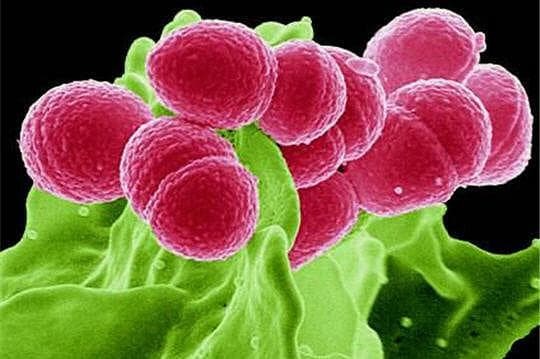
Viruses
This reason is also very common in medical practice. If the angina has arisen as a result of the defeat of the body by a virus, it is called herpetic. As a rule, enteroviruses are involved in this process. This is the name of the disease due to the specific vesicles that form on the mucous membranes. Viral angina is diagnosed most often in patients aged 3-10 years. 
Mushrooms
Fungal angina indicates obvious violations in the protective system. Candida albicans - fungus, which is present in the human body constantly. If the patient's immunity decreases, then he begins to contribute to the formation of the disease. Reduction of protective functions arises from the disease, for the treatment of which antibiotics were used. 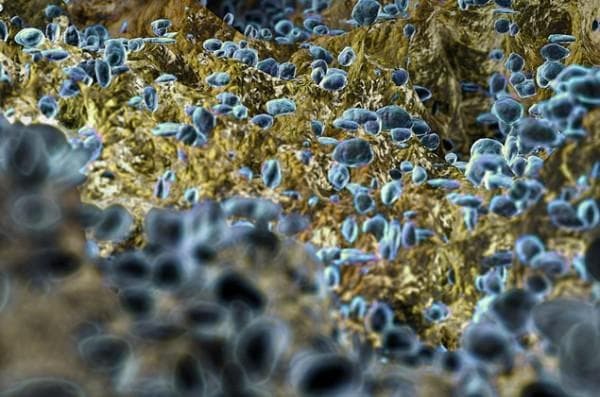
Varieties and causes of its formation
In order to determine the causative agent of angina, it is necessary to correctly diagnose its appearance. After all, every form of the disease has its own reasons for education. Classification occurs according to the indices of etiology and pharyngoscopic symptoms of pathology. Many people have a question, what is a pharyngoscopic picture? This is the data that the doctor receives during the examination of the pharynx and throat mucosa. According to the obtained pattern, these types of angina are distinguished:
- catarrhal;
- is follicular;
- lacunar;
- is fibrinous;
- herpetic;
- phlegmonous;
- is ulcerative and necrotic.
The video tells about the definition of the causative agent of sore throat:
Catarrhal
Causes of formation of catarrhal inflammation can be caused by microorganisms:
- of staphylococci;
- streptococci;
- other bacteria concentrated in the pharynx.
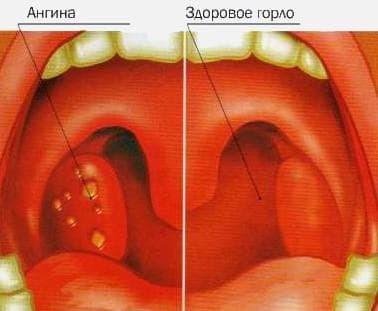
In the picture - what an angina looks like
Local immunity helps to reduce their active activity, as a result of which it is possible to prevent the formation of a pathological process. Transmission of infection is carried out by airborne droplets.
This variety of angina occurs suddenly, but its symptoms are acute. Symptoms of this form of the disease are perspiration and a small painful syndrome, the body temperature rises extremely rarely, and also does not exceed normal values. On the mucous membrane affected by the inflammatory process, the moat can detect redness and swelling, and the damage to the tonsils occurs superficially.
Poisoning of the body is of moderate severity. When analyzing blood, it is possible to detect minor changes or their complete absence. If you compare catarrhal angina with other species, then its course is easiest.
The duration of the disease is 1-2 days, and then all the symptoms of the disease go away, and the disease itself can go into another form. Here you can read more about the symptoms and treatment of catarrhal angina.
Follicular
The causative agents for this process are and denrovirus, rhinovirus, influenza virus. Promotes the development of acute infections of the tonsils of streptococcus group A. The cause of the formation of tonsillitis lies in the ingress of such viruses into the body:
- Staphylococcus aureus;
- diphtheria;
- syphilis;
- streptococcus pneumonia.
On the onset of the inflammatory process indicates an increase in temperature indicators to 38-39 degrees. In addition, the patient has severe pain in the throat during meals. Also characteristic signs of follicular angina are chills and fever. There is an increase in lymph nodes, they become painful when probed.
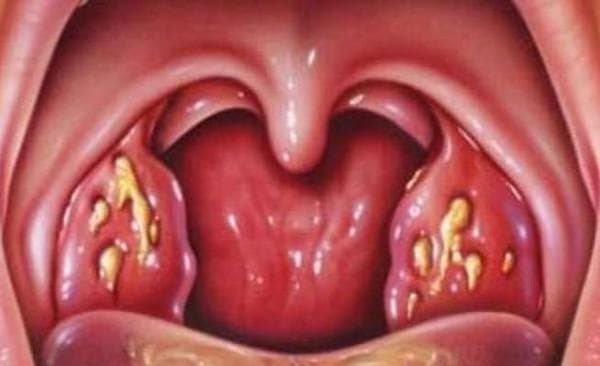
Tonsils and palatines have puffiness and redness. When a blood test is performed, the patient has a high leukocytosis, and in urine - red blood cells and traces of protein.
The result of this inflammatory process is the injection of follicles and translucence through the mucous membrane. After that they are transformed into small bubbles, which in some cases are opened. Here are described the symptoms and treatment of follicular sore throat in children.
Lacunar

Various surgical interventions in the oral cavity and tooth ailments can contribute to the formation of angina. External factors can also act as causative agents of lacunar angio .These include long-term exposure in the cold, sudden temperature failures, dampness.
For this type of disease symptoms of the previous angina( follicular) are characteristic. The course of the disease goes in a more severe form. In lymphocytes, leukocytes are contained in excess.
In addition to the swelling of the pharynx tissues, whitish deposits are formed. Often, they merge and affect the entire surface of the tonsils. The link describes the treatment of lacunar angina at home.
Purulent
Pathogens are caused by bacteria and viruses that affect the body under certain conditions. To the causes of the formation of purulent sore throat:
- various types of bacteria;
- viral infection;
- various fungi, including Candida;
- klebsiella, typhoid fever, pale spirochete;
- mycoplasmas, ureaplasmas, chlamydia.
The link describes how to treat purulent sore throat at home. Also, read the better gargle with purulent sore throat.
Herpetic
Coxsackie viruses of group A, B-3, and also ECHO viruses can act as causative agents of herpetic sore throat. Infect the disease can be through inhaled air or fecal-oral route. The peak of the prevalence of viruses falls on the autumn-summer period.
The onset of such a sore throat is the appearance of symptoms that resemble the flu. The patient has malaise, apathy, fever, poor appetite. After these signs, he develops a sharp cold, pain in the throat and drooling. Tonsils and tongue form small bubbles, inside of which there is serous content. In appearance they look like a rash of herpes. For more complicated course of the disease is characterized by the presence of diarrhea, nausea and vomiting.
The onset of the inflammatory process is accompanied by an increase in temperature indicators to 39-40 degrees. At the time of the blood test, the patient is found to have minor leukopenia. Read how the herpetic sore throat is transmitted. Symptoms of herpes sore throat in children are described here.
Phlegmonous
This pathology is characterized by a complication that has arisen against the background of other forms of angina. For phlegmonous tonsillitis incomplete opening of the mouth, nasal voice is characteristic. Here the symptoms of phlegmonous sore throat are described in detail. 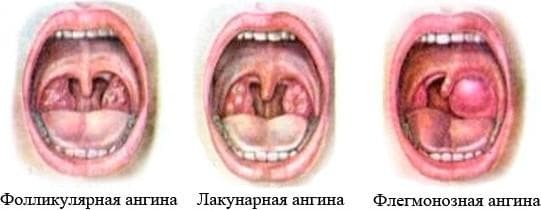
Ulcerative necrotic
The cause of this disease lies in the weakening and exhaustion of the body. Also, ulceration of necrotic angina may be caused by the presence of foci of necrosis in the oral cavity. He feels well, his body temperature does not go up. There is salivation and bad breath. Symptoms of intoxication are poorly expressed. 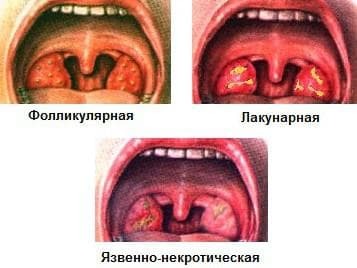
Recognizing angina is very simple, as its symptoms can not be confused with another disease. It is difficult to know the form and the reason for its formation. To do this, you need to undergo a test, after which, based on the results, the doctor will prescribe effective therapy.
Based on this, do not rely on your own efforts and treat the disease at home. Only qualified help and timely diagnostics will make it possible to forget about all the unpleasant symptoms of angina. Perhaps you will need an instruction on the use of furatsilina for gargling with angina.
